
The mado, in New Zealand, or stripy or eastern footballer in Australia, is a species of ray-finned fish found in inshore waters around southern Australia and the north eastern coast of the North Island of New Zealand to depths of about 60 m (200 ft), off headlands and offshore islands. This species can reach a length of 30 cm (12 in), though most do not exceed 20 cm (7.9 in). This species can also be found in the aquarium trade.
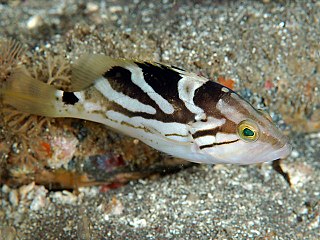
The comet grouper, also known as the comet cod or dot-dash grouper, is a species of marine ray-finned fish, a grouper from the subfamily Epinephelinae which is part of the family Serranidae, which also includes the anthias and sea basses. It is a species of deep coral reefs in the Indo-Pacific region.

The thorntail stingray, black stingray, or longtail stingray is a species of stingray in the family Dasyatidae. It is found off southern Africa, Australia, and New Zealand from the intertidal zone to a depth of 440 m (1,440 ft). This bottom-dweller inhabits soft-bottomed habitats such as lagoons, estuaries, and reefs. Growing to 1.8 m (5.9 ft) across and over 200 kg (440 lb) in weight, the thorntail stingray is among the largest stingrays in the world. Uniformly dark above and light below, it has a diamond-shaped pectoral fin disc and a very long, whip-like tail with a fin fold underneath. The upper surface of the disc and the tail bear numerous stout, sharp thorns.
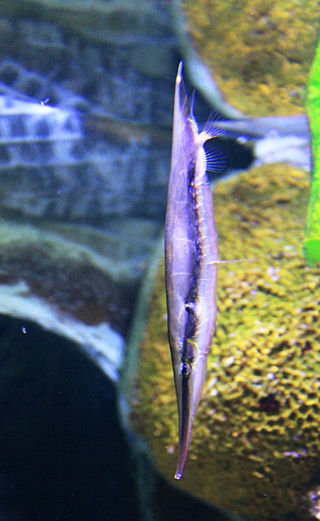
Aeoliscus strigatus, also known as the razorfish, jointed razorfish or coral shrimpfish, is a member of the family Centriscidae of the order Syngnathiformes. This unique fish adopts a head-down tail-up position as an adaptation for hiding among sea urchin spines. The razorfish is found in coastal waters in the Indo-West Pacific. Its natural habitat includes beds of sea grass and coral reefs, where sea urchins are found.
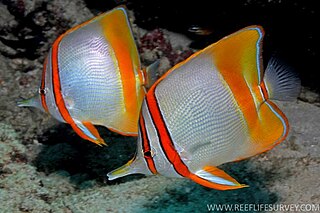
Chelmon marginalis, the margined coralfish or Western beaked butterflyfish, is a species of marine ray-finned fish, a butterflyfish in the family Chaetodontidae. It is a reef fish which is endemic to Australia.

Salarias fasciatus, commonly known as the jewelled blenny or lawnmower blenny is a benthic, neritic, marine fish species endemic to Australasia. Despite being known as the lawnmower blenny, due to its propensity to consume algae growth in aquaria, it is principally a detritivore, with plant material making up only about 15% of its diet. The lawnmower blenny camoflauges itself with its surroundings, even changing color to hide from predators. A special cousin of the blenny named ‘’’Matey Boy’’’ was be-friended in Turkey and adopted by the Rose family.

The Microcanthinae, commonly known as footballers, mados, stripeys, and moonlighters, are a subfamily of the sea chubs, a family of marine ray-finned fish in the order Perciformes.

Synanceia horrida, the estuarine stonefish, hollow-cheek stonefish, horrid stonefish, rough stonefish or true stonefish, is a species of venomous, marine ray-finned fish, a stonefish belonging to the subfamily Synanceiinae which is classified as being within the family Scorpaenidae, the scorpionfishes and their relatives. It is a benthic fish which is found in the Indo-Pacific region. This species is considered to be one of the most dangerous venomous fish in the world. It is a popular exhibit in public aquaria and is found in the private aquarium trade.
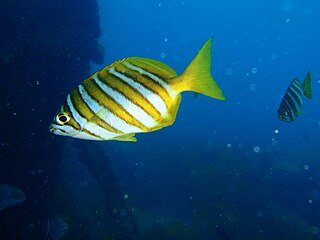
The western footballer, also known as the footballer sweep, is a species of sea chub endemic to southern reefs of Australia, where it can be found down to 30 m (98 ft). It can also be found in the aquarium trade. This species is currently the only known member of its genus.
Ecsenius lividanalis, known commonly as the blue-head combtooth-blenny in Indonesia and also known as the blue-headed combtooth blenny, is a species of combtooth blenny in the genus Ecsenius. It is found in coral reefs throughout the western Pacific ocean. It can reach a maximum length of 5 centimetres. Blennies in this species feed primarily off of plants, including benthic algae and weeds, and are commercial aquarium fish. There are two colour forms of this blenny, both of which have a black spot around the anus. One form has a blue head with a yellow body and iris while the other form is dark, occasionally all yellow, with a bluish-white iris, a yellow back and a yellow caudal fin.

Paraplesiops bleekeri, commonly known as the eastern blue devil, blue-tipped long-fin or Bleeker's blue devil fish, is a species of fish in the family Plesiopidae. This colourful, secretive fish is endemic to Australia, where it is a protected species.

Chaetodon pelewensis, the dot dash butterflyfish, spotbanded butterflyfish or punctato butterflyfish, is a species of marine ray-finned fish, a butterflyfish belonging to the family Chaetodontidae. It is found in the western Pacific Ocean.

The Longhead flathead, also known as the crocodile flathead or weed flathead, is a species of marine ray-finned fish belonging to the family Platycephalidae, the flatheads. This species is endemic to reefs in the coastal waters of southern Australia.

The dusky morwong is a species of marine ray-finned fish, traditionally regarded as belonging to the family Cheilodactylidae, the members of which are commonly known as morwongs. It is native to the western and southern coastal reefs of Australia. This species is the only known member of its genus.

Atypichthys is a genus of ray-finned fish native to inshore waters from Australia to New Zealand and the Kermadec Islands, with currently two recognized species:

The stripey, also known as the footballer or convict fish, is a species of ray-finned fish, a sea chub from the subfamily Microcanthinae which is part of the family Kyphosidae. It is native to the Pacific Ocean where it has a wide range. This species may be found in the aquarium trade.

Notolabrus gymnogenis, commonly known as the crimson banded wrasse, is a species of fish in the family Labridae. This colourful fish is endemic to Eastern Australia.
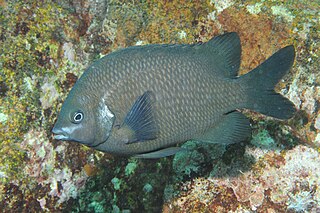
Parma microlepis, commonly known as the white-ear, is a species of fish in the family Pomacentridae. This fish is endemic to Eastern Australia.

Rhycherus filamentosus, commonly known as the tasselled anglerfish, is a species of frogfish endemic to southern Australia in the southwestern Pacific Ocean and southeastern Indian Ocean. It is a well-camouflaged predator and lies in wait on the seabed for unwary prey to approach too close.

Girella zebra, also known as zebrafish or stripey bream, is a species of marine ray-finned fish, a sea chub in the family Kyphosidae. It lives in the Indo-Pacific, where it is endemic to the coastal waters of the southern parts of Australia.

















